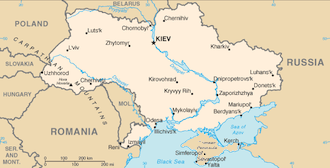Officials from both the US and NATO have eagerly jumped on board the Ukrainian claim that three tanks mysteriously milling about Donetsk Oblast are Russian tanks, but as they try to back up that claim they’re finding very weak evidence.
 Ukraine had initially identified the tanks as T-72s, but the State Department’s statement, as well as NATO’s annotated photos, identify them as T-64 battle tanks, an earlier Soviet-era model.
Ukraine had initially identified the tanks as T-72s, but the State Department’s statement, as well as NATO’s annotated photos, identify them as T-64 battle tanks, an earlier Soviet-era model.
While that might seem a minor distinction, it actually isn’t, as Russia no longer has any T-64 tanks in operation, and what they have left in storage are slated for destruction. Ukraine, by contrast, is one of only a handful of nations still using T-64 models in regular service.
Indeed, NATO’s whole basis for identifying them as Russia is a single photo showing a Russian flag on top of one of the tanks, and satellite photos from a Russian military base showing other, unidentified tanks not far from the Ukrainian border. It seems exceedingly unlikely that Russia, which has 15,000 tanks between active and reserve forces, would be dragging the far-outdated T-64 models they have left out of storage just to pass a few off to the rebels for some unknown reason.
Despite being an older model, T-64s are actually considered superior to the T-72s, though both are many decades out of date at this point, and neither would be anything resembling a game-changer in the Ukrainian civil war.
NATO and the US appear to have embraced the Ukrainian allegation, as in the past, simply because it makes Russia look bad if confirmed. Then they tried to “prove” the story and found it had as many holes in it as a 50-year-old Soviet tank.


